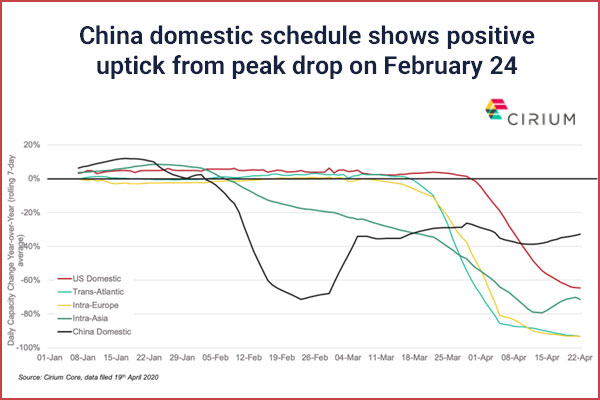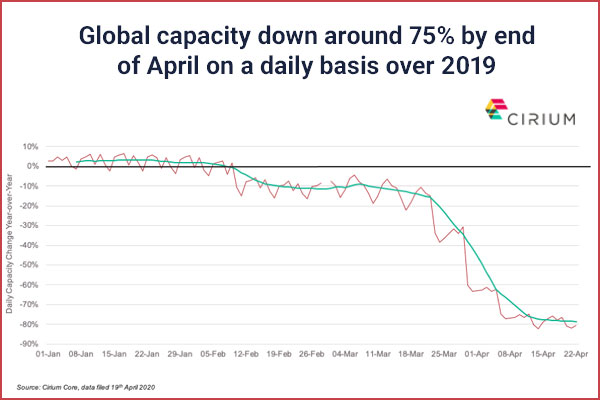A Beacon Of Hope

Travel and analytics company, Cirium is reporting that domestic airline capacity in China is beginning to recover, with over 30% of its domestic capacity returning in the past two months.
Cirium’s data indicates that China’s domestic capacity has recovered from a peak year-on-year drop of 71% on Feb. 24 to down being down just 33% on April 22.
As many countries in Asia have passed what is hoped to be the peak of the pandemic, Cirium’s data shows trends of increased air travel capacity for the region, with intra-Asia capacity improving by 10% between April 14 and April 22.
Cirium notes that global regions still under lockdown — including the US and Europe — are yet to show signs of recovery, however its analysis indicates a plateau is starting to emerge in airline capacity worldwide as per April 22.
Rob Morris, head of consultancy at Cirium’s consultancy arm, Ascend by Cirium, said in a recent webinar, COVID-19 – the Impact on Aviation: “While cancellations remain high and the recovery in domestic flights has plateaued over the last month, the ‘green shoots’ of recovery in China’s domestic market are a beacon of hope for the aviation industry.”
Morris observed that: “With airline fleets grounded around the world, the COVID-19 crisis represents an unprecedented collapse in demand for air travel. We need to see the current airline shutdown phase finally reach its end before we can assess how long the airline hibernation phase lasts – only then will we see the start-up of recovery and stabilization.”
And Morris added: “Even at this stage, growth will depend on a range of external factors, from the level of government support received by the industry to consumer confidence in the market post-lockdown.”
The COVID-19 crisis has seen a dramatic reduction in the amount of airline capacity scheduled globally. Analysis of Cirium’s schedule data indicates that global airline capacity is expected to drop by 75% by the end of April 2020, compared with the same period last year.

Given the global capacity plunge, Cirium data shows that around 16,800 passenger aircraft, including regional jets, parked around the world on April 22. This is the equivalent of almost two thirds of the entire global fleet – made up of around 26,300 passenger jets.
Said Morris: “Since the beginning of March alone, more than 12,000 passenger jets have been placed into storage globally. However, the pace of parking has slowed throughout April suggesting it is now stabilizing.”
The reverse trend has been observed in China, which accounted for 40% of the thousand passenger aircraft that returned to service over the same period, as restrictions on air travel are gradually lifted in the country.
For the remaining 9,600 aircraft in-service globally, a total of 4,076 single-aisle aircraft were tracked on April 17 compared with 13,929 on January 3. Twin-aisle jets similarly reduced from 3,993 to just 599 over the same period.
In Europe, 268 single-aisle aircraft were tracked on April 19, 2020 compared with 3,412 on January 3, with twin-aisle jets dropping from 895 to just 89 over the same period.
Across the Atlantic, a total of 1,340 single-aisle aircraft were tracked in North America on April 19, compared with 3,417 on January 3, as single-aisle jet usage continues to drop. Tracked twin-aisle aircraft have reduced from 468 to just 91 over the same period, but the reduction in widebody jets now appears to have stabilized.
The Asia-Pacific fleet witnessed a more sudden decline, with 424 single-aisle aircraft tracked on April 19 in contrast to 2,489 on January 3. Meanwhile, tracked twin-aisle jets decreased from 1,222 to 201 over this period.
Concluding, Morris said: “COVID-19 is creating a stress-scenario beyond anything we could ever have imagined in the industry. Airlines and the entire travel and tourism economy face an extremely challenging few months ahead, but with government and financial support, the sector will return to health.”
Go to https://cirium.lookbookhq.com/impactofcovid19 for more.


